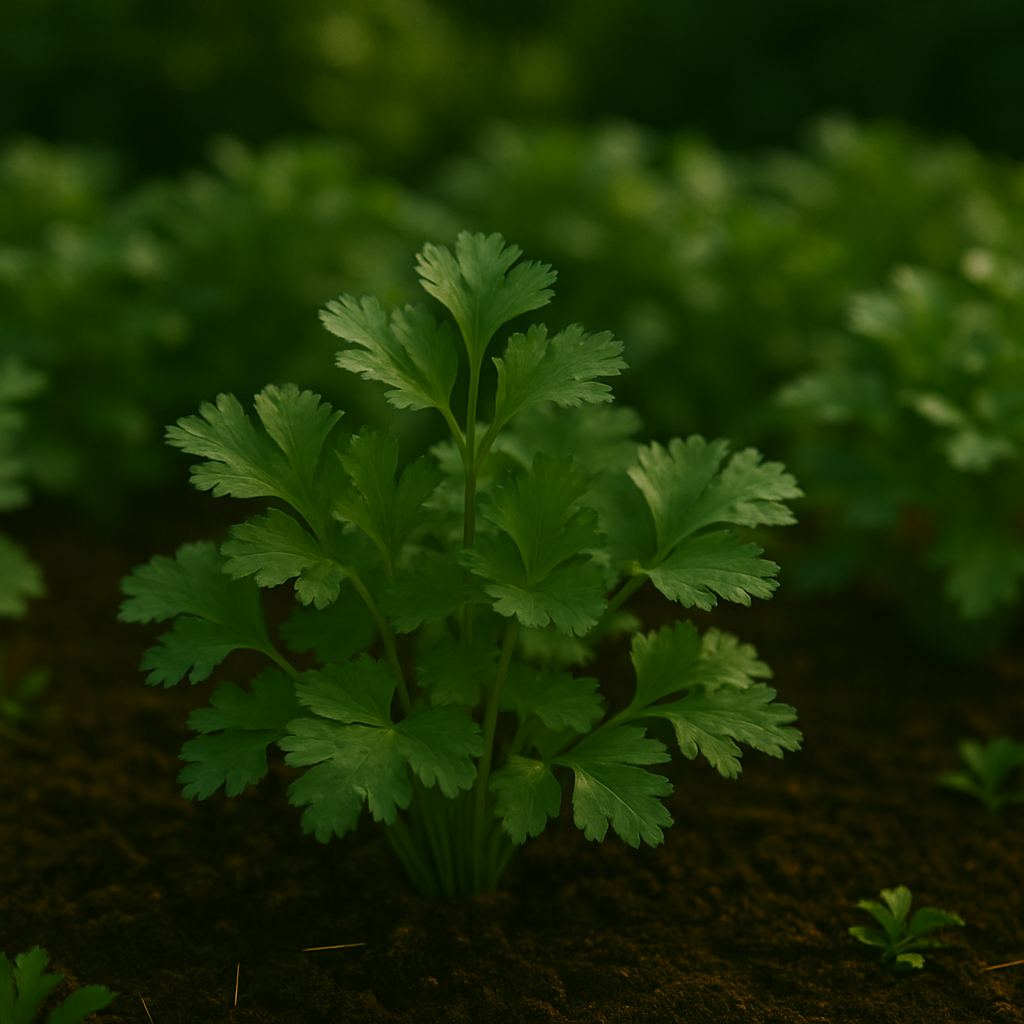Introduction
Cilantro diseases can quickly turn your thriving patch of this popular, flavorful herb into a gardener’s headache. Whether you love sprinkling fresh cilantro over tacos or blending it into homemade salsa, protecting your crop is essential for a healthy, bountiful harvest. Disease prevention isn’t just about keeping leaves green; it saves time, money, and disappointment in the kitchen.
In this post, we’ll explore the most common cilantro diseases you might encounter—like powdery mildew, bacterial leaf spot, and damping-off. You’ll learn to recognize the early warning signs, from yellowing leaves to wilting stems, so you can act fast. We’ll also share simple, real-world solutions that work for both new and seasoned gardeners, plus tips for keeping your cilantro strong all season long.
Let’s dive into the symptoms and strategies that can save your cilantro and keep your meals tasting fresh.
Common Cilantro Diseases & How to Identify Them
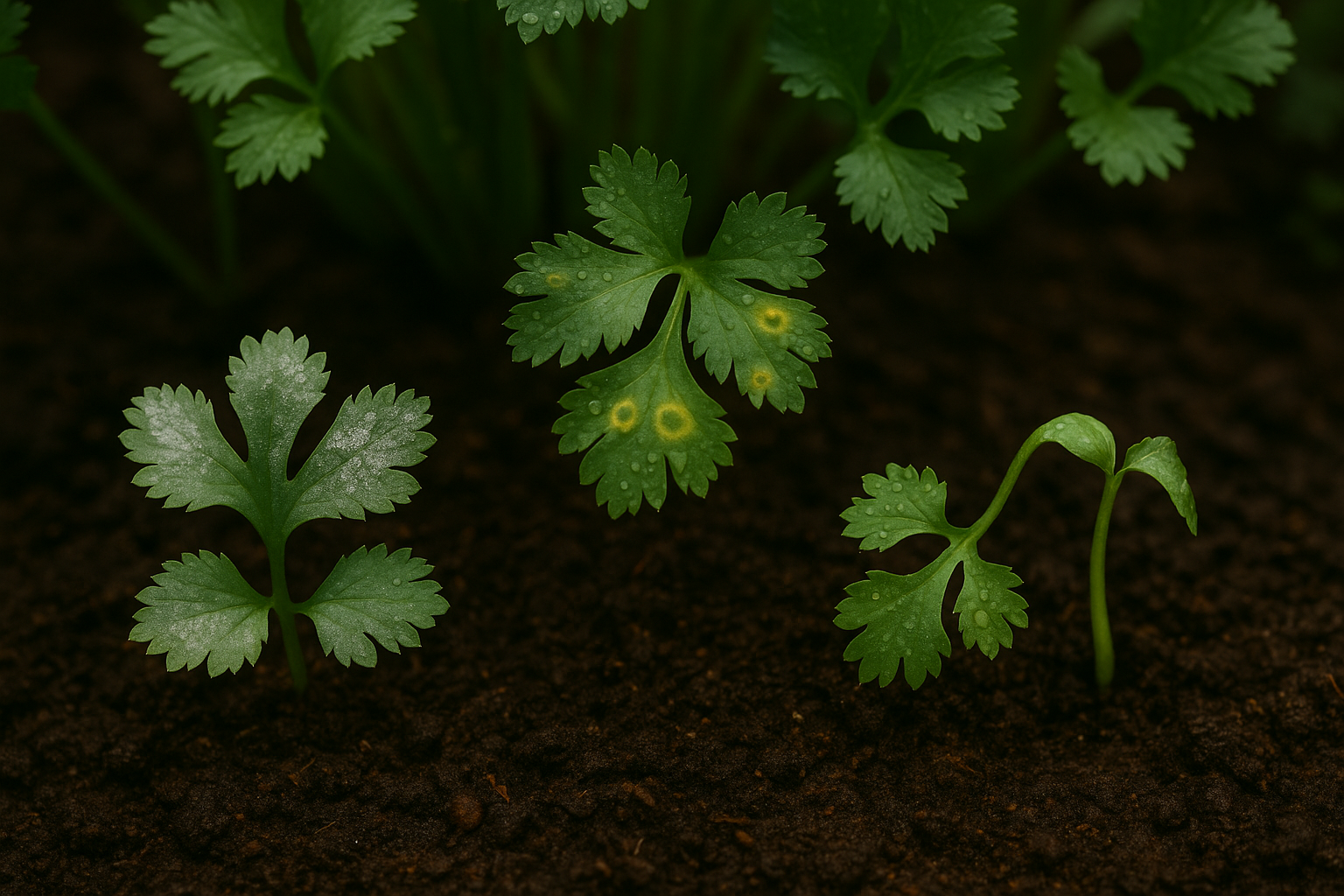
Cilantro is a flavorful herb, but it’s not immune to diseases that can quickly ruin a healthy crop. Fungal infections are among the most common issues you’ll encounter.
Powdery mildew appears as a white, powder-like coating on leaves and stems, usually starting on the oldest leaves and spreading in dry, shady conditions.
Downy mildew causes pale yellow patches on the upper surfaces of leaves and a fuzzy, grayish mold growth underneath, especially in cool, damp weather.
Damping-off, another fungal culprit, attacks seedlings, causing them to suddenly wilt, collapse, and sometimes rot at the soil line.
Bacterial leaf spot presents as dark, water-soaked spots on leaves that may eventually turn brown and dry up—often surrounded by yellow halos.
Viral diseases are harder to spot but can cause leaves to curl, develop mosaic yellow or pale green patterns, and stunt plant growth.
Unlike pest damage, disease symptoms typically don’t include holes or chewed edges—look instead for uniform spots, fuzzy coatings, or sudden wilting. Nutritional deficiencies generally create more widespread yellowing or pale leaves but without distinct spots or fuzzy growth.
To help visually identify the problem, snap close-up photos of affected leaves and compare them to online guides or extension service resources. Clear, well-lit pictures showing symptoms like white residue, yellow halos, or collapsed seedlings can make diagnosis much easier.
By checking the pattern and texture of the symptoms—whether it’s a powdery coating, spots surrounded by yellow halos, or sudden seedling collapse—you’ll quickly be able to tell the difference between diseases, pest damage, and nutrient issues.
Environmental Factors That Promote Disease
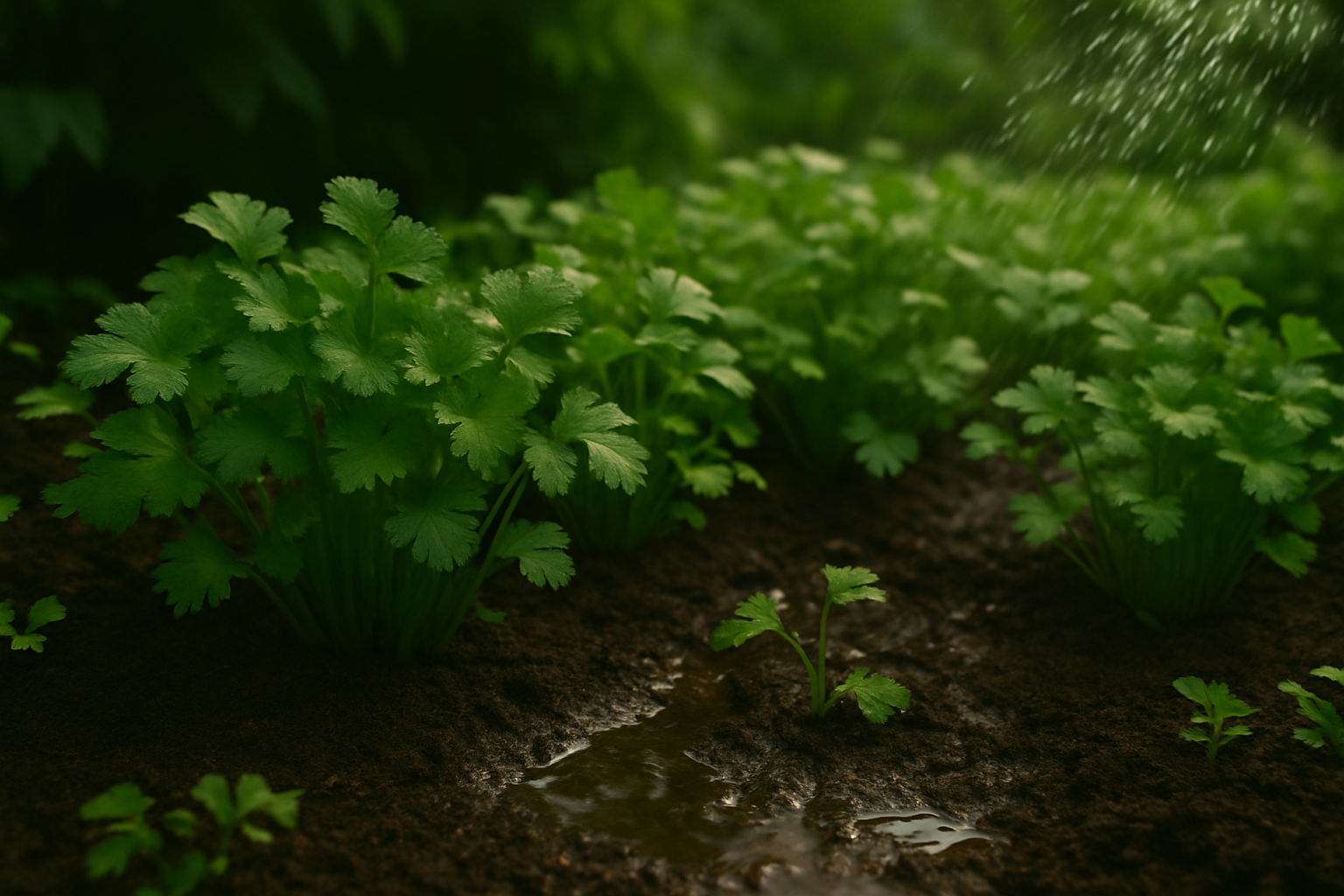
Environmental factors play a crucial role in the development of diseases in cilantro. High humidity creates the perfect breeding ground for fungal pathogens, as moisture lingering on leaves allows spores to germinate and spread. Warm temperatures, especially when paired with poor air circulation, further accelerate the growth of harmful microbes.
Cilantro thrives best in cool weather with daytime temperatures between 50–85°F and moderate humidity. These conditions can quickly become problematic if not carefully managed. Poor soil drainage is another risk factor: waterlogged soil suffocates cilantro roots and encourages diseases like root rot and damping off. Healthy cilantro prefers lightly moist, well-draining soil; soggy conditions promote the opposite.
Overcrowding plants is a common mistake that limits airflow, trapping humidity and creating microclimates ideal for disease. Give cilantro at least 6 inches between plants to reduce this risk. Finally, overhead watering can leave leaves damp for hours, increasing the chance of foliar diseases such as downy mildew or bacterial leaf spot. Instead, water early in the day at soil level so plants can dry off before nightfall.
By focusing on proper spacing, watering wisely, and ensuring good drainage and airflow, you can help cilantro resist the most common diseases linked to environmental stresses.
Integrated Solutions for Disease Management
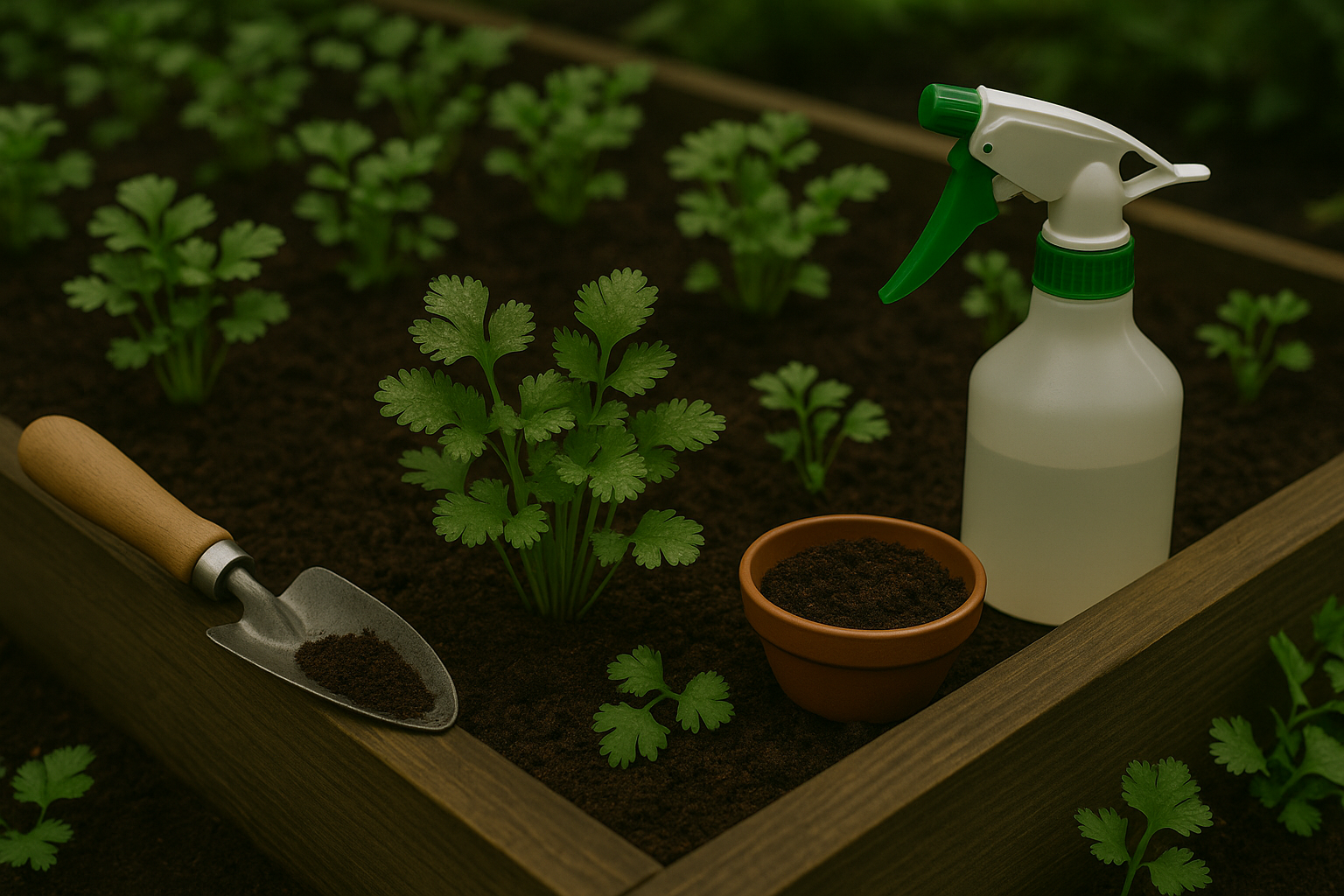
Integrated disease management combines several practical strategies to protect your garden from common threats. Prevention starts with healthy habits: space your plants properly to allow air circulation and reduce moisture buildup, which can discourage diseases like mildew and blight.
Crop rotation is another simple yet often overlooked method—by changing the location of your vegetable families each season, you can interrupt the life cycle of soil-borne pathogens. Choose disease-resistant varieties whenever possible, as these are bred to withstand threats specific to your region or crop.
Water your plants early in the day and aim for the base to keep foliage dry, which helps prevent fungal infections.
When it comes to control, organic options like neem oil, baking soda sprays (a teaspoon of baking soda with a liter of water), or a mild soap solution can be very effective for early or mild outbreaks. These safe home remedies are especially useful for edible gardens, where chemical residues are a concern.
Chemical controls, such as a copper-based fungicide or specific pesticides, are best reserved for severe or persistent problems and should be used following all label instructions.
Regardless of method, always remove and dispose of infected plants to stop diseases from spreading, and remember to disinfect your pruning tools and pots with a 10% bleach solution after each use.
Homemade sprays are excellent for early intervention and preventative care, especially for smaller gardens, while commercial treatments may be necessary when dealing with large infestations or stubborn pathogens.
By mixing these integrated strategies, gardeners can create a balanced, sustainable approach to disease management that protects both plants and the environment.
Nematodes and Root Health Issues
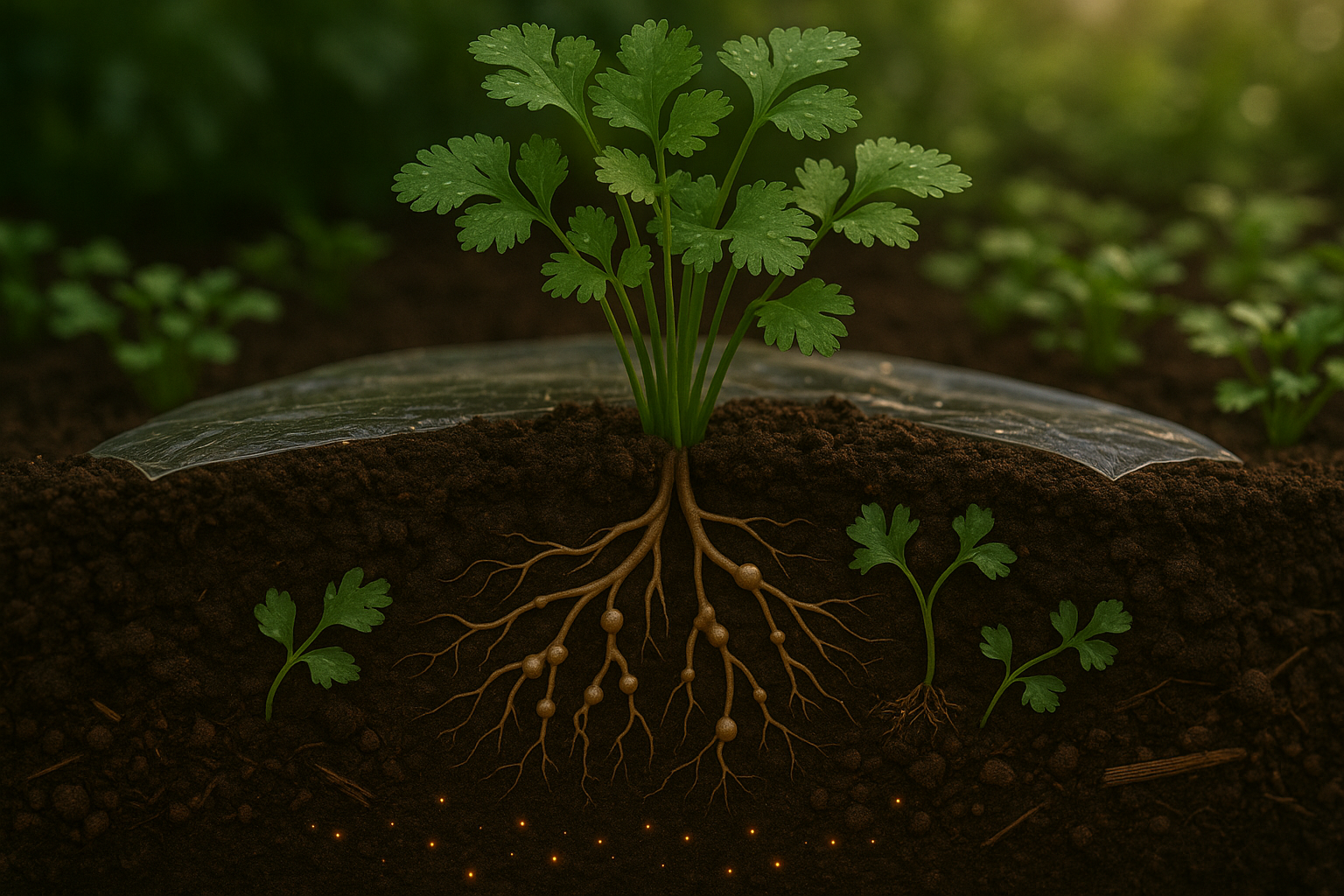
Nematodes are microscopic, worm-like organisms that live in the soil and can cause serious harm to plant roots, including those of cilantro. While some soil nematodes are harmless or even beneficial, parasitic types—like root-knot nematodes—invade cilantro roots, disrupting water and nutrient uptake. This can lead to symptoms such as stunted plant growth, yellowing leaves, and the formation of galls or knots on roots. These issues can ultimately limit harvest and reduce plant vigor.
To protect your cilantro, consider rotating crops, as nematodes often build up when the same plant family is grown repeatedly in the same spot; switching to unrelated crops helps break their lifecycle. Solarizing the soil—covering moistened ground with clear plastic for 4-6 weeks during hot weather—can significantly lower nematode populations by using heat to kill them. Incorporating organic matter like compost also encourages beneficial microbes that outcompete harmful nematodes. Whenever possible, choose nematode-resistant cilantro varieties, which are bred to tolerate or repel these pests.
By combining crop rotation, proper soil health, and resistant cultivars, gardeners can mitigate nematode damage and enjoy healthier, more productive cilantro plants.
How to Monitor and Prevent Recurrence
Staying vigilant is key when it comes to monitoring and preventing the recurrence of plant diseases in your garden. Make it a habit to inspect your garden at least once a week, closely examining leaves, stems, and soil for early signs of trouble like discoloration, spots, or mold.
Early intervention is crucial—you’ll often save plants by promptly removing affected leaves or isolating diseased sections before problems spread. For even better control, keep a garden journal to note when and where diseases appear each season. This helps you spot patterns and tackle recurring issues head-on.
Outside the growing season, don’t skip important sanitation steps:
- Clear out plant debris that could harbor pathogens
- Winterize raised beds with mulch or row covers to protect soil health
- Consider rotating crops or treating soil with organic fungicides or compost to reduce lingering disease pressure
These combined efforts—regular monitoring, detailed record-keeping, and offseason cleanup—not only reduce the chances of repeat outbreaks but also create a healthier, more robust garden year after year.
When to Seek Expert Help
Recognizing when to seek expert help can save your plants and prevent bigger problems. If you notice unusual spots, wilting that doesn’t improve with watering, sudden leaf drop, or rapid die-back, these could be warning signs of a serious disease. Moldy growth, strange cankers, or pests you can’t identify also signal the need for professional advice.
Don’t hesitate to reach out to your local extension office, master gardeners, or nearby plant clinics—they’re equipped to diagnose tough plant issues. Before contacting them, take clear photos of the affected areas and, if requested, submit a fresh sample of the disease problem in a sealed bag. Be sure to clearly note the plant species, symptoms, recent weather, and how the problem first appeared.
Experts can identify pathogens or pests, suggest specific treatments, and even recommend resistant plant varieties, giving you the best chance to restore plant health while saving time and frustration.
